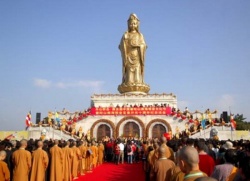Dasavidha-rājadhamma
Dasavidha-rājadhamma or Rajādhamma 10 ("tenfold virtue of the ruler") is one the Buddhist dharma that rulers of people, organisations, companies, offices, countries or other organs are purposed to hold. It could be found in Sutta, Kuddakanikāya, Jātaka, stating:
- "Dānaŋ sīlaŋ pariccāgaŋ ājjavaŋ maddavaŋ tapaŋ
- akkodaŋ avihimsañca khantiñca avirodhanaŋ”
Composition
Dasavidha-rājadhamma composes of:
1. Dāna (charity) — being prepared to sacrifice one's own pleasure for the well-being of the public, such as giving away one's belongings or other things to support or assist others, including giving knowledge and serving public interests.
2. ([[[Sīla]])] (morality) — practicing physical and mental morals, and being a good example of others.
3. Pariccāga (altruism), being generous and avoiding selfishness, practicing altruism.
4. Ājjava (honesty) — being honest and sincere towards others, performing one's duties with loyalty and sincerity to others.
5. Maddava (gentleness) — having gentle temperament, avoiding arrogance and never defaming others.
6. Tapa (self controlling) — destroying passion and performing duties without indolence.
7. Akkoda (non-anger) — being free from hatred and remaining calm in the midst of confusion.
8. Avihimsa (non-violence) — exercising non-violence, not being vengeful.
9. Khanti (forbearance) — practicing patience, and trembling to serve public interests.
10. Avirodhana (uprightness) — respecting opinions of other persons, avoiding prejudice and promoting public peace and order.
History
Historically, there is a man who exemplifies the tenfold virtue of the ruler, namely, King Ashoka (304-232 BCE), who ruled India for forty-one years. Initially, the King was a great warrior general, winning many battles, and continued to expand the
Indian empire during the first eight years of his reign. After one particularly bloody campaign, the King wandered the sight of his army’s victory, and seeing the carnage all around him, famously cried out, “What have I done?” Following this, he embraced
Buddhism, establishing a just kingdom along Buddhist lines and was known as 'Dhammashoka' or "Ashoka, the holder of dharma". He promoted wildlife protection, banning hunting for sport, built universities, hospitals for people and
animals, and constructed irrigation systems for trade and agriculture. The King also renounced the use of violence, ceasing all military campaigns
against his neighbours, instead sending monks and nuns abroad to spread the Buddhist Teachings on wisdom and kindness. Indeed, a son and daughter of King Ashoka’s who were monk and nun took Buddhism to Sri Lanka, where
it remains the predominant faith to this day. This is not to say that he promoted Buddhism at the expense of other religions, however, as he also encouraged tolerance and understanding between different creeds and ethnic groups. King Ashoka is
remembered by Buddhists and non-Buddhists alike as an example of a truly compassionate and just ruler, who lived according to the tenfold virtue of the ruler.

